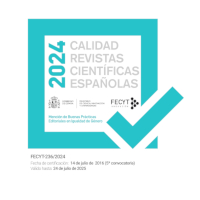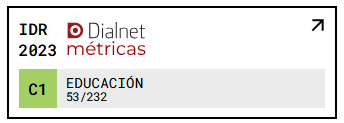Doña Jacinta 2.0
a project for the teaching of history through Facebook
DOI:
https://doi.org/10.18172/con.5077Keywords:
History Didactics, Social Network, Facebook, Doña Jacinta Martínez de SiciliaAbstract
This work will address the potential of social networks services such as Twitter or Facebook for teaching the History of Spain. A specific project will be analyzed: the Facebook page Doña Jacinta 2.0. (https://www.facebook.com/Doña-Jacinta-20-1676501339053420) created within the framework of a teaching innovation project together with students of the Primary Education Degree of the University of La Rioja in the 2017-2018 and 2018-19 academic years. On this page, Doña Jacinta Martínez de Sicilia, Duchess of Victoria, wife of General Espartero, reviews the main milestones in the History of Spain of the s. XIX in which they were involved. Her texts are accompanied by a multitude of resources: interactive maps, timelines, photomontages, pictures, memes, Kahoots, interactive games, etc.
Downloads
References
Abrahamson, C. (1998). Storytelling as a Pedagogical Tool in Higher Education. Education, 118(3), 440-451.
Alvarez-Flores E. P. y Núñez Gómez, P. (2013). Uso de redes sociales como elemento de interacción y construcción de contenidos en el aula: cultura participativa a través de Facebook. Historia y Comunicación Social, 18, 53-62. http://doi.org/10.5209/rev_HICS.2013.v18.44225 DOI: https://doi.org/10.5209/rev_HICS.2013.v18.44225
Bermejo, F. (2000). Espartero. Hacendado riojano. Instituto de Estudios Riojanos.
Burdiel, I. (2010). Isabel II. Una biografía (1830-1904). Taurus.
Buxarrais, M. R. (2016). Redes sociales y educación. Education in the Knowledge Society, 17(2), 15-20. DOI: https://doi.org/10.14201/eks20161721520
Calabuig i Serra, S., Medir I Huerta, R. M. y Donaire Benito, J. A. (2013). Participación de los alumnos en el debate político a través del Twitter. En J. J. Díaz Matarranz, A. Santisteban Fernández y A. Cascajero Garcés (Eds.), Medios de comunicación y pensamiento crítico. Nuevas formas de interacción social (pp. 633-638). Universidad de Alcalá.
De Haro, J. J. (2010). Redes sociales para la Educación. Anaya.
Díaz Serrano, J. (2013). Redes sociales, contextos virtuales y medios de comunicación. En J. J. Díaz Matarranz, A. Santisteban Fernández y A. Cascajero Garcés, (Eds.), Medios de comunicación y pensamiento crítico. Nuevas formas de interacción social (pp. 575-580). Universidad de Alcalá.
Duart, J. M. (2009). Internet, redes sociales y educación. Revista Universidad y Sociedad del Conocimiento, 6(1), 1-2.
Gamboa Fallas, M. (2022). Enseñar historia mediante las redes sociales y enseñar sobre las redes sociales mediante la historia: los alcances de las redes sociales en la enseñanza de la historia. Revista Perspectivas: Estudios Sociales y Educación Cívica, 24, 2022, 1-20. http://doi.org/10.15359/rp.24.3 DOI: https://doi.org/10.15359/rp.24.3
García Castilla, F. J. (2014). Innovación docente y redes sociales: oportunidades y retos. En A. Fernández Paradas (Ed.), Interactividad y redes sociales (pp. 245-262). ACCI.
Gere, C. (2002). Digital Culture. Reaktion books.
Lacy, S. (2009). The Facebook story: The People, the Hype and the Deals Behind the Giants of Web 2.0. Crimson Publishing.
Lambert, J. (2006). Digital Storytelling: capturing lives, creating community. Digital Diner Press.
Levy, P. (2007). Cibercultura: La cultura de la Sociedad Digital. Anthropos.
Observatorio de Innovación Educativa del Tecnológico de Monterrey (2017). Storytelling. EduTrends, 1-32. https://observatorio.itesm.mx/edutrends-storytelling
National Storytelling Association (1997). What is Storytelling? http://www.eldrbarry.net/roos/st_defn.htm
Noiret, S. (2018). Trabajar con el pasado en internet: la historia pública digital y las narraciones de las redes sociales. Ayer, 110, 111-140. DOI: https://doi.org/10.55509/ayer/110-2018-05
Scolari, Carlos Alberto (2013). Narrativas Transmedia. Cuando todos los medios cuentan. Deusto.
Shubert, A. (2018). Espartero, el Pacificador. Galaxia Gutenberg.
Takseva, T. (2013). Social Software and the Evolution of User Expertise. Future Trends in Knowledge Creation and Dissemination. Information Sciente Reference. DOI: https://doi.org/10.4018/978-1-4666-2178-7
Túñez López, M. y Sixto García, J. (2012). Las redes sociales como entorno docente: análisis del uso de Facebook en la docencia universitaria. Pixel-Bit, Revista de Medios y Educación, 41, 77-92.
Van Dijck, J. (2016). La cultura de la conectividad: Una historia crítica de las redes sociales. Siglo Veintiuno Editores.
Vermes, T. (2012). Ha vuelto. Seix Barral.
Zuazo Azpeitia, O. (2012). Redes sociales en el aula. Aula de Innovación Educativa, 216, 64-67.
Downloads
Published
How to Cite
Issue
Section
License
Copyright (c) 2022 Diego Téllez Alarcia

This work is licensed under a Creative Commons Attribution 4.0 International License.
The authors retain copyright of articles and authorize Contextos Educativos. Revista de Educación the first publication. They are free to share and redistribute the article without obtaining permission from the publisher as long as they give appropriate credit to the editor and the journal.
Self-archiving is allowed too. In fact, it is recommendable to deposit a PDF version of the paper in academic and/or institutional repositories.












